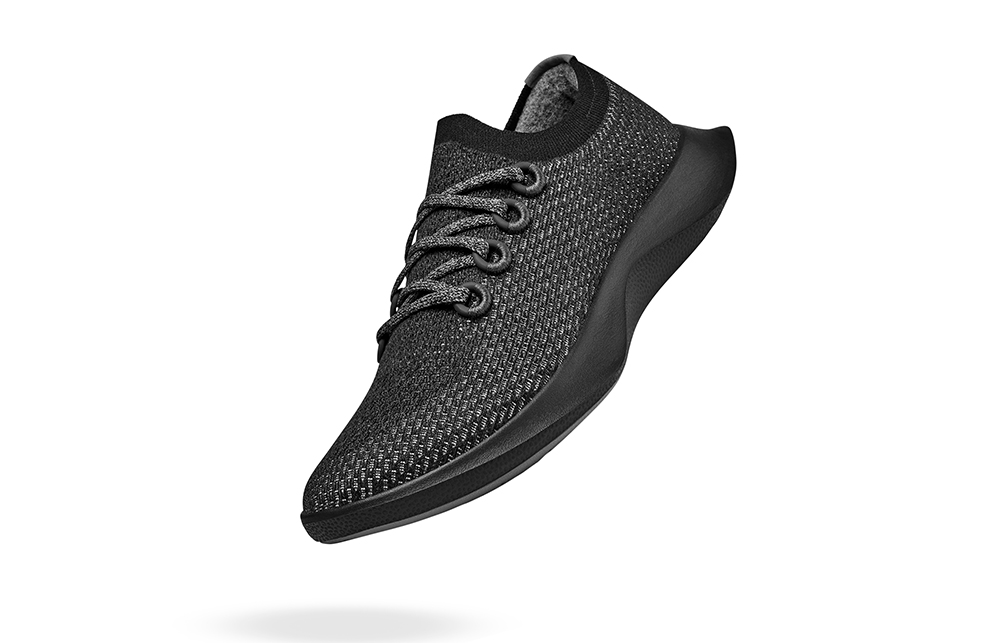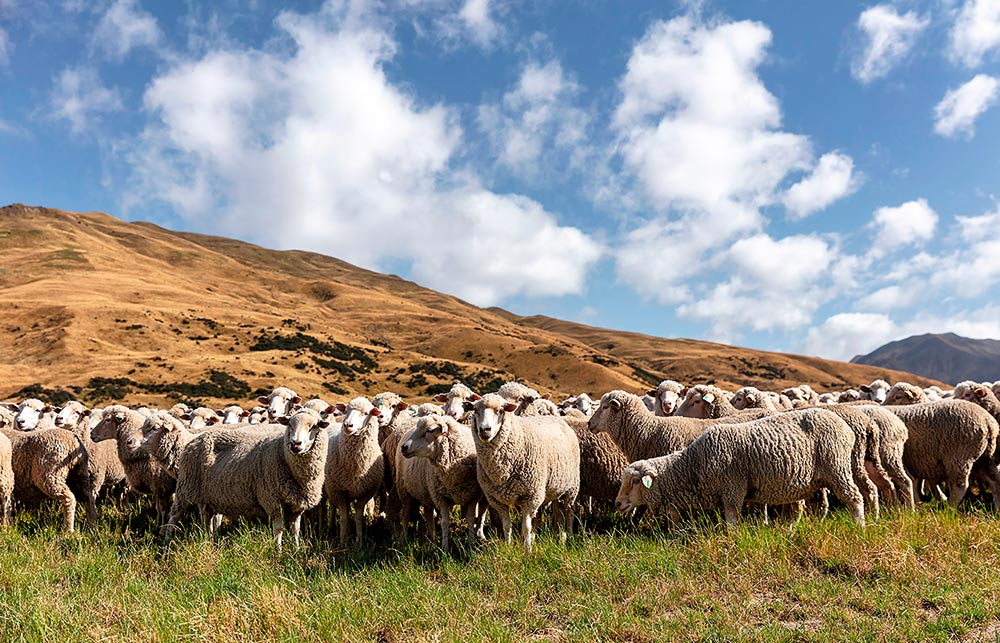
他们开始寻找线虫,这是一种能够影响土壤营养物质循环的小蠕虫。他们选择在新西兰南岛一座小山的阳面草丛中开挖,将土翻了出来,观察土下面的生物。对于一个外行来说,它看起来就像是泥土:棕色、疏松、脏乎乎的土壤。对于Allbirds(一家成立了6年的旧金山鞋履初创公司)的四名员工来说,它似乎展现了一个机会,亦是土壤生命友好、环境友好的证据——打造Allbirds鞋履的各种材料在这一过程中不会对地球造成伤害。
超过6000只粉色鼻头的美利奴羊散布在2500英亩的流动牧区,这些牧区是Glenaan Station农场的一部分。这个有着百年历史的农场距离基督城北部两小时的车程。这些动物在其正常的生活过程中会向大气释放甲烷,继而锁住热量。然而,借助这些小蠕虫,牧场土壤将在吸收二氧化碳的同时为生产羊毛的羊提供牧草,而这些羊毛将在遥远的地方成为时尚鞋履的装饰材料。
这一点对Allbirds来说至关重要,因为其品牌形象正是基于公司与消费者达成的环境友好合约。这家制鞋公司的可持续性负责人哈那•卡吉姆拉说:“有人谴责农民向大气排放碳和其他温室气体,但这个农场在碳减排方面做了大量的工作。”她还说:“我们想确保自身眼光的长远性。这里不仅包括碳排放,还有被储存的碳。”

从一开始,Allbirds就利用了当时出现的环境可持续发展趋势,并将其作为一个商业和营销卖点。公司并没有使用对地球有害的塑料,而是采用了天然材料制作鞋履。气候改革者莱昂纳多•迪卡普里奥非常喜欢Allbirds,并投资了该公司。Allbirds到目前为止筹集了7700万美元。(机构投资者包括重量级基金T. Rowe Price、富达和Tiger Global,而这家私营公司也在积极地筹集更多的资金。)Allbirds标志性的混合拖鞋是对“运动休闲”时尚运动突如其来的补充,它迅速地在喜欢休闲风的职场人士中走红,由其是硅谷。
Allbirds拥有21家零售店,其2019年销售额预计为2亿美元,是目标驱动型企业群体中十分成熟的一员,并引得其他制造商纷纷仿制其鞋履。Allbirds并没有起诉模仿者,也没有为难他们。去年,联合创始人约瑟夫•兹威灵格发表了一封公开信,敦促竞争者“剽窃我们实现可持续发展的方式”,并表示将把Allbirds基于植物的鞋帮技术透露给所有询问的企业。公司称,截至1月,20个品牌打算采用Allbirds的开源技术来制作产品。
确实,对地球的友善是Allbirds最大的卖点。4月,公司在所有销售的产品上打上了碳印记标识。公司称其制作羊毛运动鞋的碳使用量为7.1公斤,而业界平均值为12.5公斤。与此同时,Allbirds通过发布Dasher鞋款进军“性能”跑鞋领域。这款鞋的原材料为美利奴羊毛和其他可以兼做健康补品食谱的材料:桉树、甘蔗和蓖麻子油。
与耐克和现有的其他运动服饰企业竞争是一项艰巨的任务,由其是考虑到它是一款几乎纯天然的鞋履。Allbirds认为,坚持其最大的优势——有益于地球的这个亮点——便是Allbirds其始终能够处于不败之地的绝佳机会。
可再生农业可以追溯至圣经诞生的时代,当时,先人通过对其土地休耕来实现最基本的轮作,以保持其土壤的肥力。然而,这个术语源于近代的媒体和营销:杂志出版商鲍勃•罗戴尔在1989年曾经谈到了“再生”的优点,它不仅仅只是可持续性。
随着气候变化顾虑的出现,再生农业一直被誉为大气碳捕捉的方式之一。为Allbirds采购羊毛的New Zealand Merino公司的首席执行官约翰•布拉肯瑞奇说:“土壤是一个巨大的碳坑。” 这意味着土壤能够吸收碳,避免其造成影响。“如果方法得当,它可以成为全球变暖问题的一个重要解决方案。”
3月的一个早上,我在向北行进之前在基督城市中心与布拉肯瑞奇和Allbirds团队进行了会面。在农场到访期间,Allbirds在过去一周一直都在与包括北面(North Face)和运动装品牌Icebreaker在内的其他品牌碰面,谈论可再生农业。会议的议程就是合作。Allbirds的创新与可持续性副总裁嘉德•芬克说:“如果我们孤军作战的话不会造成什么影响。”有人在白板上写下了提示(“我们如何奖励种植者?”“我们如何掀起一项运动?”)以及箴言(“市场在行动方面比政策更快”)。一个名为“碳与环保主张:如何讲述这个故事”的海报上画着一副卡通画,其中有一个嗡嗡响的智能手机和多个对话泡泡,里面写着:“社会责任”、“健康”、“可追溯性”、“道德”。大堂里摆放着一个美利奴羊毛冲浪板、一张美利奴羊毛床(放在一个模拟卧室中)以及一张美利奴羊毛瑜伽垫(下面铺着美利奴羊毛地毯)。
与鞋履的制作一样,Allbirds的成功秘诀便是将真诚的环保主义与激进的营销结合起来。Allbirds的另一位创始人提姆•布朗在今年晚些时候在Zoom上表示:“我们看到,整个世界正在围绕一个全球性的问题开展合作。这是一个没有国界的问题。要应对气候和环境领域即将出现的下一个危机并没有那么困难。”

但人们是否有足够的环保意识去购买羊毛做的跑鞋而不是标准的耐克款式呢?或者在一双经典的Allbirds上花费95美元,而不是选购亚马逊上只要29.99美元、几乎有着相同外观的款式呢?事实上,有一部分人确实是这样的。市场研究公司NPD Group的体育行业高级顾问马特•鲍威尔说:“千禧一代告诉我们,他们对于产品如何制造、在哪里制造、是否符合道德规范十分关心,而且他们愿意花更多的钱去购买符合上述要求的产品。在疫情之前,消费者希望选购能够表达其价值主张的品牌。我认为如今更是如此。”
疫情和随之而来的居家隔离令的确迫使Allbirds去做出相应调整。公司关闭了其总部和大多数零售店面。兹威灵格说:“我们一直都保持着盈利状态,但我们也筹集了一笔危机基金。”几乎所有的店面自那之后都重新开业了;公司设法保住了所有450名雇员;而且Allbirds甚至退回了收到的一笔薪酬保护计划贷款。兹威灵格说:“坦白地讲,尽管我们完全有资格获得这笔贷款”,但我们认为,将这笔款项让给那些在风投资金方面没有Allbirds丰厚的其他公司,是公司的道德义务。
我们并不是在说Allbirds不屑利用市场的这一危机时刻。公司如今正专注于其跑鞋Dasher。有人怀疑公司是否可以成功地进入这个由耐克等公司以及亚瑟士、新百伦(New Balance)和布鲁克斯(Brooks)等知名专业品牌主导的市场。《跑步圣经》杂志(Runner’s World)的高级评测主编杰夫•登盖特说:“我真不知道为什么会有公司选择在2020年进军跑鞋领域。这是一个竞争异常激烈的市场。”
再者,日常的运动鞋市场在Allbirds诞生之前便已是如此。公司称,Dasher的推出创造了其史上第三高的单日销售额,而排名前两位的单日最高销售额则出现在假日季。兹威灵格说:“在这个时候说某家公司很幸运会让人感到很奇怪。”兹威灵格此前是一名生物科技工程师,曾经举办晚宴招待当时还是专业足球运动员的布朗,布朗后来成为了公司的联合创始人。“但是我们还是幸运的:跑步没有被禁止。”Allbirds一开始只在线上销售,但如今其半数店面都在美国之外,包括成都、阿姆斯特丹、柏林、东京。布朗说:“在我看来,整个世界在眼下比以往任何时候需更要这款独特的产品。”
在新西兰的Glenaan Station农场,Allbirds相对于其他大牌的市场排名较为靠后,原因在于,其老顾客允许羊毛供应牧羊人向其农场进行大量的投资。第四代农场主保罗•恩索最近花费了10多万美元来从经过其牧场的冰川河节流出了一条“小溪”,来喂养牲畜。我问他这条小河流对其羊毛生产有什么好处?恩索眨了眨眼,满脸疑惑。他说:“它最终会流向海洋。对于生态系统来说,我们将其看作是生物多样性资产,也是为了水的卫生。”
但即便在这个仙境般的丘陵地带也存在现实主义者。距离Glenaan Station农场不远的地方就是Castle Hill Station农场,由乔斯和凯瑟琳范•克朗德特持有,他们在1984年从荷兰移民新西兰。(“这里的空间更大。”凯瑟琳解释道。)来自于其3000头美利奴羊的羊毛也流入了Allbirds。不过,凯瑟琳从来没有穿过他们的鞋。她问:“鞋舒服吗?我本可以从线上预订,但我们这代人真的不大喜欢用网络。”
乔斯看着该夫妇8000英亩的农场时说:“美利奴羊毛自身也具有一定程度的广告效应。有一部分公众有能力购买这类产品,而且这类人群希望了解产品的出处。羊毛背后的故事与产品自身有着几乎相同的价值。”
如果Allbirds想要在市场中胜出,则需要让消费者相信这个故事,并保持言行一致。(财富中文网)
本文另一版本登载于《财富》杂志2020年10月刊,标题为《没有印记的鞋履》。
译者:冯丰
审校:夏林
他们开始寻找线虫,这是一种能够影响土壤营养物质循环的小蠕虫。他们选择在新西兰南岛一座小山的阳面草丛中开挖,将土翻了出来,观察土下面的生物。对于一个外行来说,它看起来就像是泥土:棕色、疏松、脏乎乎的土壤。对于Allbirds(一家成立了6年的旧金山鞋履初创公司)的四名员工来说,它似乎展现了一个机会,亦是土壤生命友好、环境友好的证据——打造Allbirds鞋履的各种材料在这一过程中不会对地球造成伤害。
超过6000只粉色鼻头的美利奴羊散布在2500英亩的流动牧区,这些牧区是Glenaan Station农场的一部分。这个有着百年历史的农场距离基督城北部两小时的车程。这些动物在其正常的生活过程中会向大气释放甲烷,继而锁住热量。然而,借助这些小蠕虫,牧场土壤将在吸收二氧化碳的同时为生产羊毛的羊提供牧草,而这些羊毛将在遥远的地方成为时尚鞋履的装饰材料。
这一点对Allbirds来说至关重要,因为其品牌形象正是基于公司与消费者达成的环境友好合约。这家制鞋公司的可持续性负责人哈那•卡吉姆拉说:“有人谴责农民向大气排放碳和其他温室气体,但这个农场在碳减排方面做了大量的工作。”她还说:“我们想确保自身眼光的长远性。这里不仅包括碳排放,还有被储存的碳。”
从一开始,Allbirds就利用了当时出现的环境可持续发展趋势,并将其作为一个商业和营销卖点。公司并没有使用对地球有害的塑料,而是采用了天然材料制作鞋履。气候改革者莱昂纳多•迪卡普里奥非常喜欢Allbirds,并投资了该公司。Allbirds到目前为止筹集了7700万美元。(机构投资者包括重量级基金T. Rowe Price、富达和Tiger Global,而这家私营公司也在积极地筹集更多的资金。)Allbirds标志性的混合拖鞋是对“运动休闲”时尚运动突如其来的补充,它迅速地在喜欢休闲风的职场人士中走红,由其是硅谷。
Allbirds拥有21家零售店,其2019年销售额预计为2亿美元,是目标驱动型企业群体中十分成熟的一员,并引得其他制造商纷纷仿制其鞋履。Allbirds并没有起诉模仿者,也没有为难他们。去年,联合创始人约瑟夫•兹威灵格发表了一封公开信,敦促竞争者“剽窃我们实现可持续发展的方式”,并表示将把Allbirds基于植物的鞋帮技术透露给所有询问的企业。公司称,截至1月,20个品牌打算采用Allbirds的开源技术来制作产品。
确实,对地球的友善是Allbirds最大的卖点。4月,公司在所有销售的产品上打上了碳印记标识。公司称其制作羊毛运动鞋的碳使用量为7.1公斤,而业界平均值为12.5公斤。与此同时,Allbirds通过发布Dasher鞋款进军“性能”跑鞋领域。这款鞋的原材料为美利奴羊毛和其他可以兼做健康补品食谱的材料:桉树、甘蔗和蓖麻子油。
与耐克和现有的其他运动服饰企业竞争是一项艰巨的任务,由其是考虑到它是一款几乎纯天然的鞋履。Allbirds认为,坚持其最大的优势——有益于地球的这个亮点——便是Allbirds其始终能够处于不败之地的绝佳机会。
可再生农业可以追溯至圣经诞生的时代,当时,先人通过对其土地休耕来实现最基本的轮作,以保持其土壤的肥力。然而,这个术语源于近代的媒体和营销:杂志出版商鲍勃•罗戴尔在1989年曾经谈到了“再生”的优点,它不仅仅只是可持续性。
随着气候变化顾虑的出现,再生农业一直被誉为大气碳捕捉的方式之一。为Allbirds采购羊毛的New Zealand Merino公司的首席执行官约翰•布拉肯瑞奇说:“土壤是一个巨大的碳坑。” 这意味着土壤能够吸收碳,避免其造成影响。“如果方法得当,它可以成为全球变暖问题的一个重要解决方案。”
3月的一个早上,我在向北行进之前在基督城市中心与布拉肯瑞奇和Allbirds团队进行了会面。在农场到访期间,Allbirds在过去一周一直都在与包括北面(North Face)和运动装品牌Icebreaker在内的其他品牌碰面,谈论可再生农业。会议的议程就是合作。Allbirds的创新与可持续性副总裁嘉德•芬克说:“如果我们孤军作战的话不会造成什么影响。”有人在白板上写下了提示(“我们如何奖励种植者?”“我们如何掀起一项运动?”)以及箴言(“市场在行动方面比政策更快”)。一个名为“碳与环保主张:如何讲述这个故事”的海报上画着一副卡通画,其中有一个嗡嗡响的智能手机和多个对话泡泡,里面写着:“社会责任”、“健康”、“可追溯性”、“道德”。大堂里摆放着一个美利奴羊毛冲浪板、一张美利奴羊毛床(放在一个模拟卧室中)以及一张美利奴羊毛瑜伽垫(下面铺着美利奴羊毛地毯)。
与鞋履的制作一样,Allbirds的成功秘诀便是将真诚的环保主义与激进的营销结合起来。Allbirds的另一位创始人提姆•布朗在今年晚些时候在Zoom上表示:“我们看到,整个世界正在围绕一个全球性的问题开展合作。这是一个没有国界的问题。要应对气候和环境领域即将出现的下一个危机并没有那么困难。”
但人们是否有足够的环保意识去购买羊毛做的跑鞋而不是标准的耐克款式呢?或者在一双经典的Allbirds上花费95美元,而不是选购亚马逊上只要29.99美元、几乎有着相同外观的款式呢?事实上,有一部分人确实是这样的。市场研究公司NPD Group的体育行业高级顾问马特•鲍威尔说:“千禧一代告诉我们,他们对于产品如何制造、在哪里制造、是否符合道德规范十分关心,而且他们愿意花更多的钱去购买符合上述要求的产品。在疫情之前,消费者希望选购能够表达其价值主张的品牌。我认为如今更是如此。”
疫情和随之而来的居家隔离令的确迫使Allbirds去做出相应调整。公司关闭了其总部和大多数零售店面。兹威灵格说:“我们一直都保持着盈利状态,但我们也筹集了一笔危机基金。”几乎所有的店面自那之后都重新开业了;公司设法保住了所有450名雇员;而且Allbirds甚至退回了收到的一笔薪酬保护计划贷款。兹威灵格说:“坦白地讲,尽管我们完全有资格获得这笔贷款”,但我们认为,将这笔款项让给那些在风投资金方面没有Allbirds丰厚的其他公司,是公司的道德义务。
我们并不是在说Allbirds不屑利用市场的这一危机时刻。公司如今正专注于其跑鞋Dasher。有人怀疑公司是否可以成功地进入这个由耐克等公司以及亚瑟士、新百伦(New Balance)和布鲁克斯(Brooks)等知名专业品牌主导的市场。《跑步圣经》杂志(Runner’s World)的高级评测主编杰夫•登盖特说:“我真不知道为什么会有公司选择在2020年进军跑鞋领域。这是一个竞争异常激烈的市场。”
再者,日常的运动鞋市场在Allbirds诞生之前便已是如此。公司称,Dasher的推出创造了其史上第三高的单日销售额,而排名前两位的单日最高销售额则出现在假日季。兹威灵格说:“在这个时候说某家公司很幸运会让人感到很奇怪。”兹威灵格此前是一名生物科技工程师,曾经举办晚宴招待当时还是专业足球运动员的布朗,布朗后来成为了公司的联合创始人。“但是我们还是幸运的:跑步没有被禁止。”Allbirds一开始只在线上销售,但如今其半数店面都在美国之外,包括成都、阿姆斯特丹、柏林、东京。布朗说:“在我看来,整个世界在眼下比以往任何时候需更要这款独特的产品。”
在新西兰的Glenaan Station农场,Allbirds相对于其他大牌的市场排名较为靠后,原因在于,其老顾客允许羊毛供应牧羊人向其农场进行大量的投资。第四代农场主保罗•恩索最近花费了10多万美元来从经过其牧场的冰川河节流出了一条“小溪”,来喂养牲畜。我问他这条小河流对其羊毛生产有什么好处?恩索眨了眨眼,满脸疑惑。他说:“它最终会流向海洋。对于生态系统来说,我们将其看作是生物多样性资产,也是为了水的卫生。”
但即便在这个仙境般的丘陵地带也存在现实主义者。距离Glenaan Station农场不远的地方就是Castle Hill Station农场,由乔斯和凯瑟琳范•克朗德特持有,他们在1984年从荷兰移民新西兰。(“这里的空间更大。”凯瑟琳解释道。)来自于其3000头美利奴羊的羊毛也流入了Allbirds。不过,凯瑟琳从来没有穿过他们的鞋。她问:“鞋舒服吗?我本可以从线上预订,但我们这代人真的不大喜欢用网络。”
乔斯看着该夫妇8000英亩的农场时说:“美利奴羊毛自身也具有一定程度的广告效应。有一部分公众有能力购买这类产品,而且这类人群希望了解产品的出处。羊毛背后的故事与产品自身有着几乎相同的价值。”
如果Allbirds想要在市场中胜出,则需要让消费者相信这个故事,并保持言行一致。(财富中文网)
本文另一版本登载于《财富》杂志2020年10月刊,标题为《没有印记的鞋履》。
译者:冯丰
审校:夏林
They came in search of nematodes, tiny worms that cycle nutrients through soil. They dug their hands into thatches of reedy grass on a sunny hillside on the South Island of New Zealand, turning over the earth, peering at what lived below. To an outsider, it looked like dirt: brown, crumbly, messy earth. To four employees of Allbirds, the six-year-old San Francisco footwear startup famous for its fuzzy woolen sneaker, it looked like an opportunity: life-affirming, environmentally pleasing proof that the materials that go into Allbirds shoes don’t hurt the planet in the process.
More than 6,000 pink-nosed merino sheep roam the 2,500 rolling acres that constitute Glenaan Station, a century-old farm two hours north of Christchurch. Through the normal course of being sheep, these animals spew methane into the atmosphere, trapping heat. Yet thanks to those small worms, the soil on this antipodean ranch sucks up carbon dioxide while growing grass to feed the sheep that produce the wool that adorn the feet of hipsters a world away.
This means everything to Allbirds, whose very identity is wrapped up in the eco-friendly compact it makes with its consumers. “Farmers get a bad rap for contributing carbon and other greenhouse gases to the atmosphere,” says Hana Kajimura, the sneaker company’s head of sustainability, who was visiting to check one of Allbirds’ sources of wool. “But this farm is doing so much to draw down carbon at the same time,” she adds. “We want to make sure that we’re looking at the whole picture. Not just what’s being emitted but also what’s being stored.”
From its start, Allbirds tapped into the then-emerging trend of environmental sustainability as a commercial and marketing attribute. Instead of planet-killing plastic, it made shoes with natural materials. Climate crusader Leonardo DiCaprio liked his Allbirds so much he invested in the company, which has raised more than $77 million to date. (Institutional investors include heavyweight funds T. Rowe Price, Fidelity, and Tiger Global, and the company, which is privately held, is actively raising more money.) The signature Allbirds hybrid slipper-shoe, an out-of-nowhere addition to the “athleisure” fashion movement, quickly caught on with casually clad professionals, particularly in Silicon Valley.
With 21 retail stores and 2019 sales estimated at $200 million, Allbirds is a full-fledged member of the purpose-driven corporate set. It has spawned a legion of copycat shoes, and rather than litigating, Allbirds makes life easy for imitators. Last year cofounder Joseph Zwillinger wrote an open letter urging rivals to “please steal our approach to sustainability” and offered to send the recipe for Allbirds’ plant-based soles to anyone who asked. As of January, 20 brands intended to release products made according to the Allbirds not-secret sauce, the company says.
Indeed, kindness to the planet is one of Allbirds’ biggest selling points. In April it slapped a carbon footprint label on everything it sells. It claims to use 7.1 kilograms of carbon to manufacture a wool sneaker, compared with an industry average of 12.5 kilograms. Around the same time, Allbirds jumped into the field for “performance” running shoes with the Dasher. It is made from merino wool and other materials that could double as the recipe for some kind of health tonic: eucalyptus, sugarcane, and castor bean oil.
It’s a tall order to go up against Nike and other athletic-apparel incumbents, especially with a nearly all-natural shoe. Allbirds figures that sticking with its best advantage—its good-for-the-planet sheen—represents its best chance of not getting left in the mud.
*****
Regenerative agriculture dates back at least to biblical times, when the ancients practiced rudimentary crop rotation by letting their fields lie fallow in order to keep the soil rich with nutrients. The term, however, has more recent roots in media and marketing: Magazine publisher Bob Rodale talked in 1989 about the virtues of “regeneration” as opposed to mere sustainability.
As climate change concerns have surged, regenerative agriculture has been touted as a way to sequester carbon from the atmosphere. “Soil is a huge carbon sink,” says John Brakenridge, CEO of New Zealand Merino, the agency that sources wool for Allbirds. This means that soil absorbs carbon, mitigating its impact. “Done right, this can be a big part of the solution to what we’re facing in global warming.”
One morning in March, I meet Brakenridge and the Allbirds team in downtown Christchurch, before heading up north. In between farm visits, Allbirds has spent the past week participating in a conference with other clothing brands, such as North Face and the activewear label Icebreaker, about regenerative agriculture. Collaboration is the order of the day. Says Jad Finck, Allbirds’ vice president of innovation and sustainability: “Nothing’s going to happen if we’re all siloed.” On a whiteboard, someone has written prompts (“How might we reward growers?” “How might we start a movement?”) and maxims (“The market can act faster than policy”). A poster titled “Carbon & Environmental Claims: How to Tell the Story” includes a cartoon of a buzzing smartphone and various words in speech bubbles: “social responsibility,” “wellness,” “traceability,” “ethical.” There’s a merino wool surfboard in the lobby, a merino wool bed in a mock bedroom, and a merino wool yoga mat on the merino wool carpeted floor.
This combination of earnest environmentalism and aggressive marketing is as much the Allbirds recipe as the makeup of its shoes. “You’ve seen the world coalesce around a global problem,” says Tim Brown, the other Allbirds founder, when we speak over Zoom later in the year. “It’s a problem that doesn’t know borders. It’s not too hard to draw a bow to the next crisis looming around the climate and the environment.”
But do people care enough about the environment to buy running shoes made of wool rather than a standard pair of Nikes? Or to spend $95 on a pair of classic Allbirds when Amazon sells a nearly identical-looking version for $29.99? In fact, a certain segment of people do. “Millennials tell us that they are very concerned about how products are made, where they’re made, whether they’re made ethically, and that they’re willing to pay more money for those that are,” says Matt Powell, a senior sports industry adviser at NPD Group, a market research firm. “Pre-COVID-19, the consumer wanted to align with brands that expressed their values. And I think that’s even more true now.”
The pandemic and subsequent stay-at-home orders did force Allbirds to adapt. It closed its headquarters and most of its retail stores. “We’ve always had a profitable business, but we amassed a rainy-day fund,” says Zwillinger. Nearly all the stores have since reopened; the company managed to avoid laying off any of its 450 employees; and Allbirds even returned a Paycheck Protection Program loan it had received. “Frankly, we were very eligible for it,” says Zwillinger, but notes the company nevertheless felt a moral obligation to free up funds for businesses less flush with venture money than Allbirds.
None of which is to say Allbirds is above capitalizing on a perilous moment in the marketplace. It is now focused on its running shoe, the Dasher. Skeptics doubt the company can successfully muscle into a market dominated by the likes of Nike and established specialty brands including Asics, New Balance, and Brooks. “I don’t know why anybody would get into the running shoe space in 2020,” says Jeff Dengate, senior test editor of Runner’s World magazine. “It’s a very competitive market.”
Then again, so was the everyday sneaker market before Allbirds came around. The company says the Dasher’s launch produced its third-best single-day sales ever, with the two better days having come in the holiday season. “It feels weird to say you’re lucky in a time like this,” says Zwillinger, a former biotech engineer who hosted a dinner for Brown, a former professional soccer player, and then became his cofounder. “But we kind of got lucky: Running’s not canceled.” Allbirds started by selling strictly online, but now about half its stores are outside the U.S., including in Chengdu, Amsterdam, Berlin, and Tokyo. Says Brown, “It felt like the world needed this particular product, more than ever, in this moment.”
*****
Back at Glenaan Station in New Zealand, Allbirds’ place in the market relative to more well known brands takes a back seat to the fact that its patronage allows the shepherd who supplies its wool to make impressive capital improvements to his farm. Paul Ensor, a fourth-generation rancher, recently spent more than $100,000 to fence off from grazing cattle a “wee stream” of the glacial river that runs along his acreage. I ask how the stream benefits his wool production. Ensor blinks at me, confused. “It just runs out to sea,” he says. “For the ecosystem. We look at it as an asset for biodiversity, for water health.”
But even in these fairy-tale rolling hills, there are realists. Not far from Glenaan Station is Castle Hill Station, a farm owned by Jos and Catherine Van de Klundert, who emigrated from the Netherlands to New Zealand in 1984. (“More space,” explains Catherine.) The wool from their 3,000 merino sheep also gets spun into Allbirds, though Catherine’s never put on a pair herself. “Are they comfortable?” she asks. “I could have ordered them online, but I’m from a generation that doesn’t really like to do that.”
“The thing about merino,” Jos says, looking out over the couple’s 8,000 acres, “is that it’s more or less marketing. There’s a certain part of the public that can afford it, and those sort of people want to know where the product is coming from. The story behind the wool has nearly the same value as the product itself.”
For Allbirds to win in the marketplace, it will need consumers to take that story and run with it.
A version of this article appears in the October 2020 issue of Fortune with the headline “A shoe with no footprint.”






